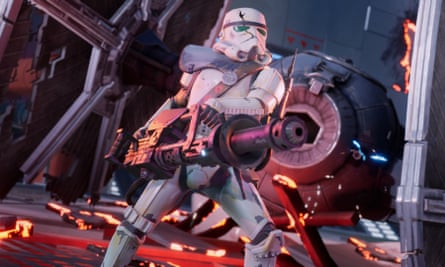I’ve talked a lot about the declining state of the games industry in 2024: after an infusion of cash during the pandemic, when everybody was looking for safe ways to distract themselves and socialise indoors and the games industry’s growth was temporarily supercharged, this year has been an overcorrection. Studios and corporations that expanded too fast, made too many hires and acquisitions, have been laying off staff and shuttering studios. Developers looking for work have been finding fewer opportunities. And the games whose development was disrupted by the pandemic have been taking longer to make it out into the world, resulting in a comparatively sparse slate of titles this year compared with the bonanza in 2023.
You could see Summer Game Fest – the smaller event in Los Angeles that has de facto replaced E3 – as a reflection of this diminishment. What was once an enormous, expensive-looking sensory assault of a trade show in the cavernous halls of the LA Convention Centre is now a small cluster of buildings a few blocks from Skid Row. What were once ostentatious press conferences are now 90-minute-long trailer livestreams that you can watch on your laptop. I found it hard not to feel glum on my first day in Los Angeles last week; I felt like the best days of the games industry might be well behind us.
But maybe there’s another way to look at it. In Los Angeles last weekend, presenter Geoff Keighley opened the Summer Game Fest showcase with a graphic showing the bestselling games of 2024 on Steam – and almost all of them are indie (or indie-ish) games. Among them were Palworld, the Pokémon-with-weapons breakout hit of January; Helldivers 2, the squad shooter that Sony surely can’t have had huge expectations for; Hades II, the Greek-mythology-flavoured arthouse action game; Manor Lords, about directing a feudal society; Balatro, the fiendish fever-dream poker game; and, uh, Supermarket Simulator. These are the most successful games in terms of units sold, but creatively, as I wrote last month, we’re also in a brilliant period for independent games.
The blockbuster end of the games industry is in the doldrums. Ballooning budgets and high-profile flops such as Redfall from Microsoft and Suicide Squad from Warner are resulting in a really boring approach, where seemingly every game has to either be attached to an enormous long-running franchise, or a live-service attention sink designed to get money out of players for years. The stakes are too high for any kind of risk-taking. The big publishers taking part in Summer Game Fest last weekend – namely, Ubisoft, EA and Microsoft – bore this out: the headline games of Microsoft’s showcase were Call of Duty Black Ops 6, DOOM: The Dark Ages, Perfect Dark, Indiana Jones and Gears of War: E-Day, all part of decades-old franchises. Ubisoft had Star Wars Outlaws and Assassin’s Creed, a series that began in 2007. EA had Dragon Age: The Veilguard, reviving a franchise last seen 10 years ago, and Skate, also ancient. All of these games looked good, as you’d hope from entertainment products that cost hundreds of millions to make, but they’re nothing new.

Happily, there were hundreds of more novel games in the weekend’s many trailer showcases, and playable in Los Angeles at the smallish campus where Summer Game Fest was held this year. I played UFO 50, a collection of 50 different, surprisingly substantial games wrapped up as an alternate-history 1980s anthology; Tales of the Shire, a game about cooking meals for your Hobbit neighbours; Fear the Spotlight, a 90s-flavoured horror game; Arranger, an arrestingly unusual role-playing puzzle game that reminded me of Crypt of the NecroDancer; and While Waiting, a darkly comedic cartoon game about wasting time and the essential futility of life that feels like a playable nihilistic comic strip. Watching the Summer Game Fest show and the other showcase livestreams over the weekend, I saw hundreds more.
We’re not seeing a great deal of innovation from the biggest companies in games right now. But as shown by that list of this year’s top 10 Steam successes, the next breakout games might not come from them. Innersloth, makers of the pandemic-era megahit Among Us, announced during Summer Game Fest that they were setting up a new fund (amusingly called Outersloth) for indie developers with good ideas. Meanwhile, Blumhouse – the horror film production company – is getting into video games with its own label of lower-budget horror games, starting with a slate of six. I’m seeing signs of creative regeneration at this end of the scale, and it’s making me feel optimistic.
During the heyday of E3, a decade or more ago, the event represented a games industry that always seemed to be in ascendancy. Everyone was competing, creatively and technically, to be the next big thing, to one-up each other with splashy reveals and showy events. It was gaudy and often tasteless, but it was exciting. These days the games industry already is the next big thing: it’s a mature entertainment industry where the pace of change is slower and the biggest games and companies are unimaginably bigger than they were before. The most successful companies in games – EA, PlayStation, Nintendo, Epic Games with Fortnite, Riot with League of Legends, 2K with Grand Theft Auto – don’t need to spend millions on a flashy event when they have millions of players already. There’s less of that competition, less drive from game publishers and console makers to prove themselves.
But there are also many more people involved than there were before: more players, more games, and more game creators at every scale, all over the world. Los Angeles in June isn’t the centre of the gaming universe any more: the next big thing could come from anywhere. It’s easy to see stagnation, assimilation and repetition if all you’re looking at is the top end of the games industry. If you want to feel excited about the future, all you have to do is look elsewhere.
What to play

While you’re waiting for Ubisoft’s epic open world adventure Star Wars Outlaws, you should definitely check out Star Wars: Hunters. Just launched on smartphones and Nintendo Switch, it’s a team-based arena shooter, which lets you take part as various creeds from the Star Wars universe including Jedis, bounty hunters, Wookiees and Jawas – all with their own weapons and skills, of course. Hunters is beautifully presented, featuring recognisable locations from the films, and lots of familiar sounds and music. Mobile gaming veteran Zynga has ensured that the surprisingly intuitive controls make it accessible for fans, whatever their shooting skills.
Available on: Nintendo Switch, iPhone, Android
Estimated playtime: 20+ hours
What to read

-
Amid the endless gunfire belching from hundreds of Summer Game Fest trailers over the weekend, the Wholesome Direct show, which streamed live on Saturday evening was an oasis of calm. Here’s a nice interview with the organisers.
-
Is Microsoft about to announce an Xbox handheld? VGC has rounded up all the evidence, including comments Xbox chief Phil Spencer made during an interview at the Summer Game Fest.
-
It’s worth checking out IGN’s roundups, if you want to know what Ubisoft and Xbox have coming up Gears of War returns? Ten minutes of Star Wars Outlaws footage?! It’s all here …
-
I loved Polygon’s roundup of the best garden games to play while you’re outside this summer. It’s quite US-centric, but fun – and things have changed a lot since Swing Ball …
What to click
-
Call of Duty: Black Ops 6 first look – 300GB of spies, zombies and Margaret Thatcher
-
Perfect Dark, Indiana Jones and a new Gears of War: all the new games from the Xbox Games Showcase
-
Animal Well – beautifully wrought indie underground adventure
-
Civilization 7 and more announced at Summer Game Fest
-
SpaceWar is back! Rebuilding the world’s first gaming computer
-
Playing Kafka review – a well-intentioned but sanitised attempt at adapting the unadaptable
Question Block

This week’s question comes from Oli Guy, one half of the Bonus Points podcast who asked on X:
“When interacting with water that kills the player, at what point should it kill them? Instantly? When it covers their head? Can’t step in to it at all?”
Contained within this seemingly simple question is one of the most important dichotomies in modern game design process: is a video game an immersive role-playing experience in which authenticity is paramount, or is a game a machine of play, like a Monopoly board or a pinball table, where the failure state (ie drowning) should be as brief as possible so that the player can get back to playing. If the former is most important then we have a lot of problems – when a player falls into water, the game should do a lot of calculations about how heavy they are, if they have the skill to swim, if there are any strong currents, and then calculate the outcome – in this case, you’d get a potentially lengthy drowning animation, but that will get boring after a while. That’s the problem with reality. Look at fast travel – it’s not realistic that you can instantly whiz from one point on the map to another but it is conducive to enjoyable play. So what do you do?
A lot of games provide visual clues about the potential deadliness of water: shallow, safe stretches might be lighter in colour, for example; in the 2D era, water that could be traversed was often transparent, which told the player it was part of the explorable space (Sonic the Hedgehog for example), but if it was opaque (Aladdin) it was death juice. So there can be no definitive rule, because different games have different design approaches and priorities. It seems crazy that your characters in Elden Ring or Dragon’s Dogma can’t swim and will immediately drown, while Link can explore the waters of Hyrule as long as he has some stamina. In a realistic role-playing game, we should at least get a short, authentic drowning animation when the player character is exposed to deadly water – that would provide both a lesson and a punishment to the player. But in an online team-based shooter, it should be over as soon possible to get you back in the game.
If you think this matter is trivial, the website TVTropes has a vast wiki on which games do or do not allow swimming, while the Elden Ring subreddit has long discussion threads about the deadliness of watery domains, where one user casually states, “swimming lessons are expensive in the Lands Between”. Ultimately, most players don’t seem to mind if their character is subject to a gruesome drowning animation or just dies the moment they touch the surface. Just like in any area of game design or in fact life in general, people just want the rules to be clear and consistently applied.
If you’ve got a question for Question Block – or anything else to say about the newsletter – hit reply or email us on [email protected]
Source: theguardian.com


